30+ Foolproof Ways to Increase Website Traffic

So you’ve created your website. You’ve listed all your products and added the details of your services. Unfortunately, nothing much is happening. No one is visiting and, consequently, no one is buying. What’s missing?
Website traffic. Simply having a website isn’t enough. You need to tell people about your site and make it easy for them to find it. Luckily, there are plenty of strategies and techniques you can use to make doing so a whole lot easier.
In this post, we’ll explain the importance of choosing the right tactics to promote your site. Then, we’ll provide you with 30+ foolproof ways to increase your website traffic. We’ll cover how to use content marketing, email marketing, community, and much more. Let’s jump in!
Choosing the Best Tactics for Boosting Website Traffic
There are a plethora of traffic-driving tactics you can use to boost your website traffic. However, figuring out which ones are right for you can be challenging.
Ultimately, there’s no one-size-fits-all answer. You know your business, your current situation, and your goals (and if you don’t, check out our complete guide to starting a business).
That said, there are a few things to help you determine which digital marketing tactics you should be using and what to skip, including:
- Your budget. Some of these tactics are free. Some have a cost attached. It should go without saying that you ought to spend some money if you want to be effective at driving traffic to your site, but your budget will help you decide how and where you should be allocating that money.
- Your knowledge level. Pick tactics you feel comfortable executing. Most of us, for example, could start blogging about our industry. Keyword research requires some knowledge to get going and ensure you pick the right data, but the barrier to entry is relatively low. Technical Search Engine Optimization (SEO) is a step (or few) up from that.
- Your goals. If you’re looking to drive traffic to increase brand awareness, content marketing is essential. If you only want people to come to your site to make a purchase, pay for targeted traffic on social media. In all cases, SEO should form part of your traffic-boosting strategy.
We recommend taking some time to familiarize yourself with the tactics available to you, then starting with the ones you’re most comfortable with. It may take some trial and error to figure out a strategy that works best for you.
30+ Foolproof Ways to Increase Website Traffic
Now that we understand the importance of choosing strategies for driving traffic, let’s get into what the best ones are. Below are 30+ foolproof ways to increase your website traffic.
1. Answer Niche-Specific Questions
No matter where in the buying cycle your potential customers are, they’re going to have questions that need answering. These could be top of the funnel (like “what is content marketing?”) or further down the funnel (like “which content marketing tools are best for content planning?”)
By answering these questions, you are putting your business in front of potential customers. So how do you go about finding the questions that potential customers are asking?
Your first port of call should be Google. Simply searching for your topic will start to give you ideas. For example, as you can see in the image below, Google is giving you the kind of questions you need to answer, right there in the search results:
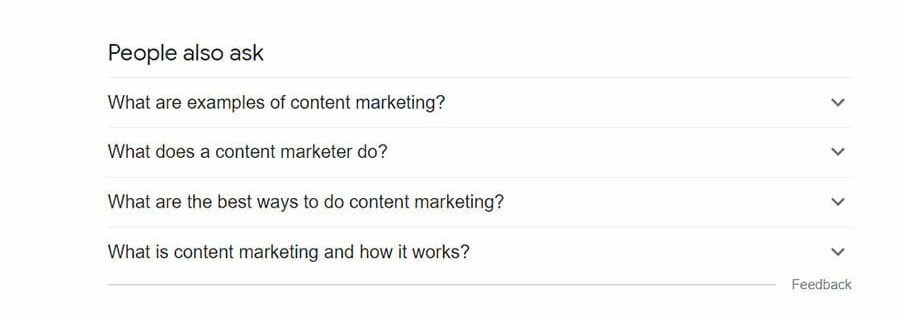
These are People Also Ask boxes (or PAA boxes). Getting your content to appear in them is a surefire way to drive website traffic. You’ll also notice that you get more and more questions to answer when you start clicking these search results:
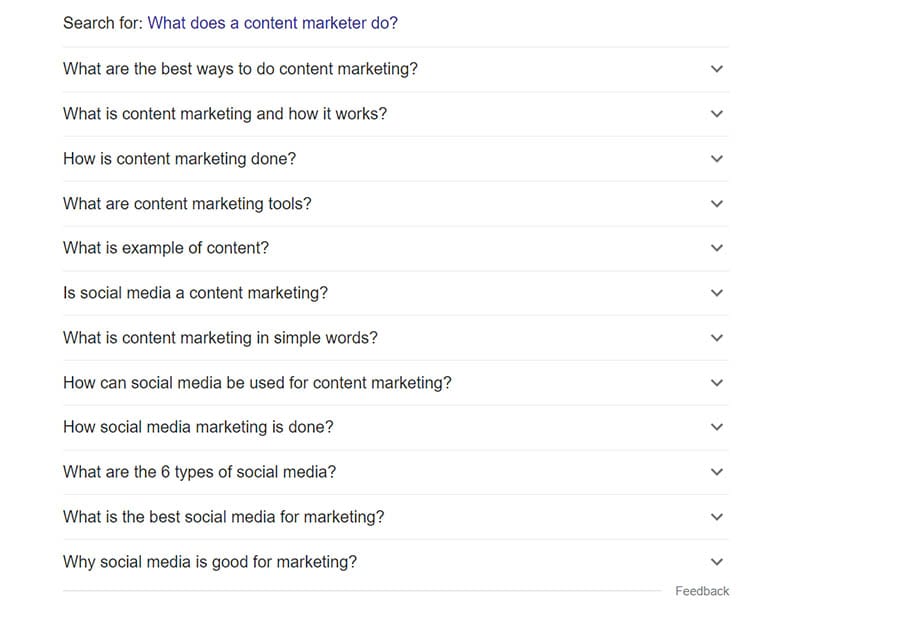
All you need to do is start collecting this information and using it to inform your Frequently Asked Questions (FQA) and Question and Answer (Q&A) content. There are also plenty of ways to automate collecting this data.
If you want to collect the data straight from the search results, you can use a plugin such as SEO Minion. If you want to take it a little further, you can use a freemium tool like AlsoAsked or AnswerThePublic.
2. Produce Evergreen Content
If you sell a seasonal product or service, it makes sense to create seasonal content. However, if you want to drive traffic to your site all year round, you need to produce evergreen content.
Evergreen content is pretty much what it says on the tin — it’s content that can drive traffic to your site all year round. There are fewer troughs and peaks, resulting in more reliable and consistent traffic.
There are many types of evergreen content (and most of the topics and ideas can be found in the tools mentioned just below). However, some of the most consistently successful formats include:
- How-to guides
- Q&As and FAQs
- Step-by-step processes or tutorials
- Ultimate guides
- Product reviews and round-ups
- Training guides
One way to make sure this type of evergreen content continues to be successful is regularly updating it. Periodically review the content and make sure that the advice is up-to-date and relevant. That way, you’ll keep sending on-topic traffic to your site year after year. It’s the gift that keeps on giving!
Get Content Delivered Straight to Your Inbox
Subscribe to our blog and receive great content just like this delivered straight to your inbox.
3. Create Eye-Catching Visual Content
It’s worth noting that with this tactic, you’re more likely to get links and exposure on other sites that help drive traffic to your site over time — unless, of course, you can attach your visuals to the kind of content people are actively searching for.
There is a handful of visual content you could create. One of the most popular is visualizing data that is relevant to your niche.
You can also create infographics that help people understand complex topics quickly. There are plenty of online tools that you can use to make this easier. A popular option is Canva:
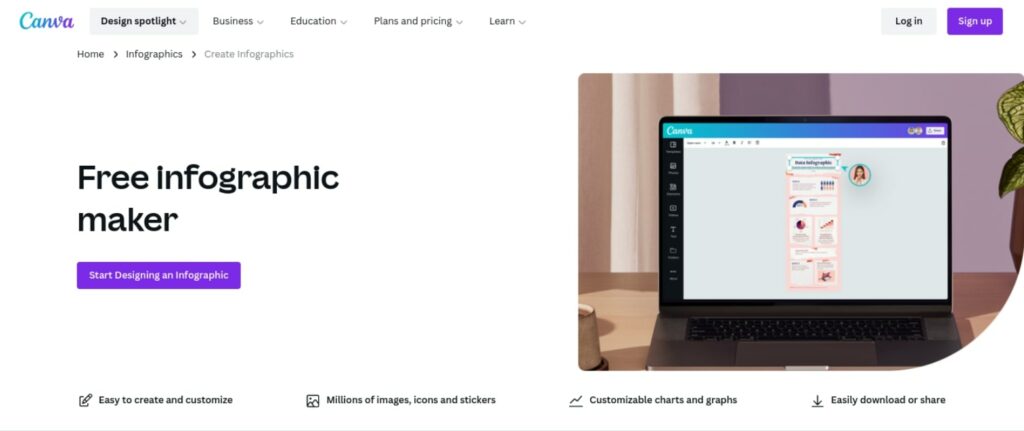
You can also take photographs that you can license via Creative Commons, resulting in your business getting cited on other sites.
4. Create Expert Roundups
Another tried-and-tested way to drive traffic to your site is by creating expert round-ups within your niche. It can be relatively easy to get people in your industry to share their thoughts on a particular topic. At the end of the day, we’re all trying to promote our business.
The great thing about expert roundups is that both sides benefit. You get content that can drive traffic when it’s shared by its participants. While participants also benefit from the exposure that they get by being featured on your site.
You can easily find experts within your industry using tools like Ahrefs, Buzzsumo, and Buzzstream Discovery — all of which are mentioned later in this article. You can then reach out to the experts and ask them for an opinion on an evergreen topic. It’s a win-win-win content marketing tactic.
5. Always Be Repurposing
No matter what kind of traffic-driving content you create, you need to ensure you make the most of it. Don’t just use the content once. Use it across different channels and get more bang for your buck.
Need a few ideas? Here are some ways you can repurpose your content marketing:
- A presentation can be recorded and uploaded to YouTube or a podcasting service
- The same presentation can be transcribed using a service like otter.ai and can become a blog post with a bit of tweaking
- Visual content for guides and blog posts can be repurposed for social media
- Blog posts can be periodically sent out to an email marketing list
- Take internal processes and turn them into whitepapers
- Combine blog posts with new content for whitepapers and eBooks
- Curate your teams’ tweets for tips and tool roundups
The list is almost endless. The more places your content appears, the more chances you have to drive traffic back to your site.
6. Update Stagnant Content
What about the content you’ve created in the past? Is it losing traffic? Did it peak before seeing a slow decline?
Don’t ignore it — you can give it the kiss of life with a little bit of love — and that’s much quicker to do and cheaper to produce than another piece of content.
There are loads of ways to identify stagnant content. The most obvious place to start is Google Analytics or Google Search Console. If the piece has performed well in the past, it stands to reason that it can perform well again.
A few tools have popped up recently that analyze this data for you. Anything that takes out some of the manual labor is a big benefit in our book. A popular option is Animalz Revive:
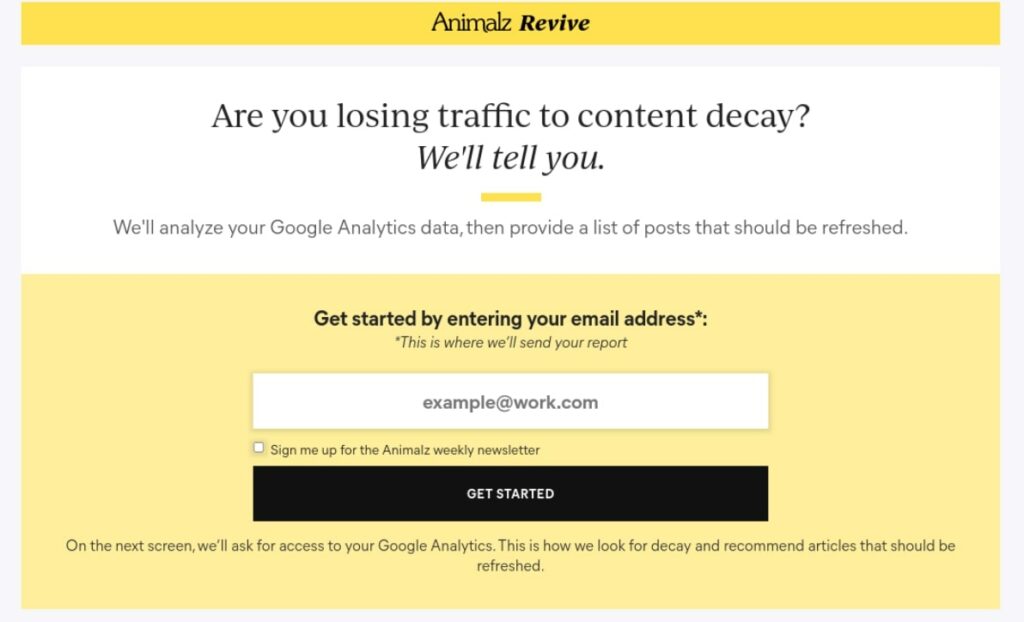
Not all content marketing is about creating something new. It’s smart to keep an eye on what you’ve created before.
7. Always Be Outreaching
Outreach is vital. You need to get your content in front of the right people. They are the ones that share your content; that link to your content; and that can help amplify your content.
Getting started with outreach begins with a list. You can build a list of sites and journalists relevant to both your niche and the content you’ve created. Outreach is challenging, and response rates are low. You need to build lists with 100s of sites and journalists to get a good Return On Investment (ROI) for your outreach efforts.
8. Crunch Data to Find Similar Content
If you need help finding sites and journalists, there are a few tools to choose from. Let’s take a look at some of the most popular.
Ahrefs Content Explorer
With Ahrefs, you can find sites and journalists according to topic. With just a few clicks and some refining of the search results, you can grab the data for hundreds of relevant sites. This saves hours of manual work.
The data it grabs for you includes (but isn’t limited to):
- The pages that similar content appears on (and by default, the site)
- Top authors
- The domain rating (essential if you’re looking to build links)
- The number of domains that link to the piece of content
- Estimated traffic
- Who tweeted the content
You’ll get an overview of the topic, similar to what you see here:

You can also look at the details at a URL level.
BuzzSumo
BuzzSumo is one of the most loved tools for finding people who write about topics you cover. Alongside handy content research tools, BuzzSumo has a topic feature that allows you to build outreach lists at scale.
The data you can see includes:
- Trending and popular content for your chosen topic
- Social stats around those articles (including Facebook, Twitter, Pinterest, and Reddit stats)
Another more recent feature allows you to find journalists that cover the type of content you’ve created:
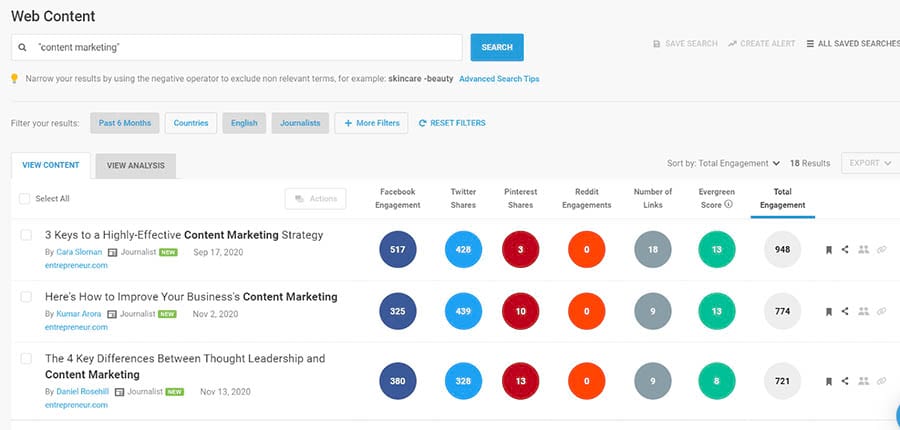
Clicking their name enables you to gather the data required to reach out to them:
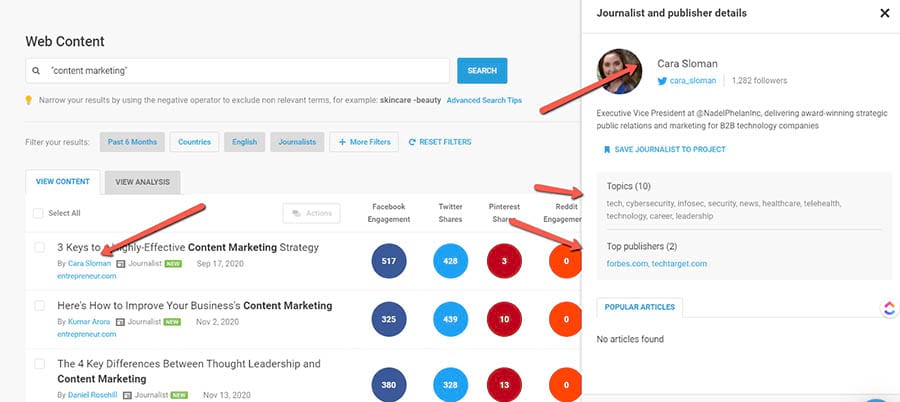
Then you need to keep all that data in a centralized place so that you can track your efforts. When you’re working on a strict budget, a shared Google Sheet is enough.
If you have a team, you’ll be better off with purpose-built software like Pitchbox or BuzzStream. These tools will allow you to upload the lists you’ve created so you can qualify the results and reach out to the people you want to get in front of.
Ensuring you track as much as possible is critical both for outreach and ensuring people see your content. If nobody sees it, it’s never going to be successful.
9. Consider Guest Posting
Guest posting can be an excellent way to drive website traffic by expanding your reach. You can contribute guest posts on relevant, quality websites in your niche and include a link back to your site in the author bio box.
Here are a few things to look out for when choosing a site you might want to guest post on:
- Does the site have a decent amount of traffic?
- Does it write mainly about your niche (you’ll want to stay away from general “we-cover-everything” type sites)?
- Does it have respected or expert writers on its staff or guest post roster?
- Does the site have a lot of pages indexed by Google?
- Does the site have high social engagement metrics?
- Does the site match your target audience?
When trying to identify and create a guest blogging strategy, it’s best to go for quality over quantity. Google is good at spotting patterns, and if it thinks you’re trying to game the system, you could find yourself in trouble with the search engine powers-that-be.
10. Reach Out to Influencers
Influencers have been a hot topic for a few years now, with many getting a lot of love from some of the world’s biggest brands. But influencer marketing isn’t just for high-flyers — small brands can get in on it too.
Influencer marketing can also work in pretty much every niche. You just have to know where to look. For example, you probably wouldn’t use an Instagram influencer to drive traffic to an attorney’s website — it just isn’t a fit.
So how do you go about finding influencers that fit your business and your website’s content? Well, there are a number of tools that can help: Klear and Upfluence are two places you can get started:
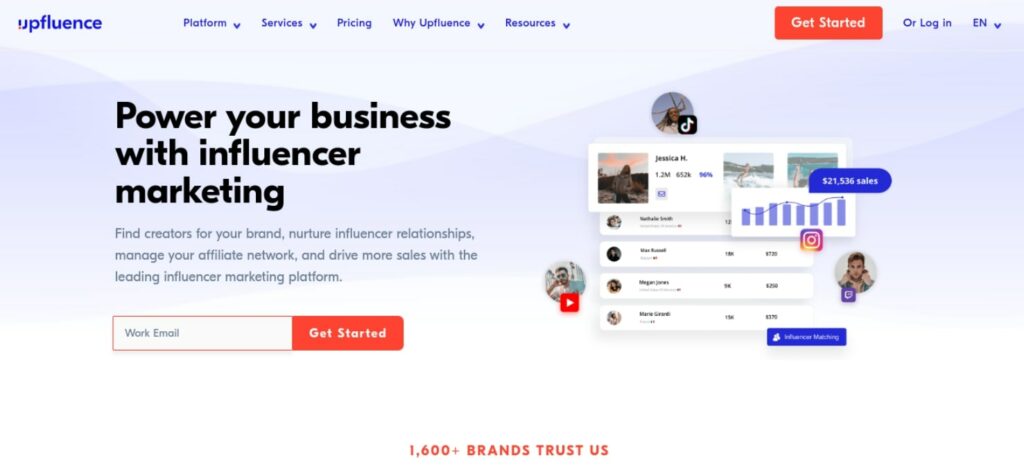
Additional options include:
Keep in mind that it’s not just about social media. Bloggers are also influencers, and they can be very effective when it comes to driving traffic and brand awareness. Social media is time-sensitive, whereas blog content can send a steady stream of traffic for much longer, sustained periods.
11. Grow Your Email List
Email marketing is still an incredibly effective technique for driving website traffic. Unfortunately, you can’t just open a MailChimp account (or whatever your email marketing service of choice might be). You need people to email.
There are many tips, tricks, and strategies for getting people to sign up for your emails, including:
- Incentivizing sign-ups (with a discount, for example)
- Hiding content behind a paywall that only subscribers can access
- Dotting Calls To Actions (CTA)s across your site
However, these aren’t going to help much unless you already have a steady stream of traffic.
There are a few things you can do to achieve this.
For example, it’s a good idea to get involved in events, whether this means sponsoring them, talking at them, or hosting them. You can also create ads on social media and run a competition or giveaway (which we’ll discuss later in this post) to incentivize engagement.
12. Participate in Online Communities
Participating in online communities can not only drive traffic to your site, but it can also help establish your business as an expert in its niche. There are many ways you can do this, but in our experience, the ones that can drive the most traffic are Quora and Reddit:
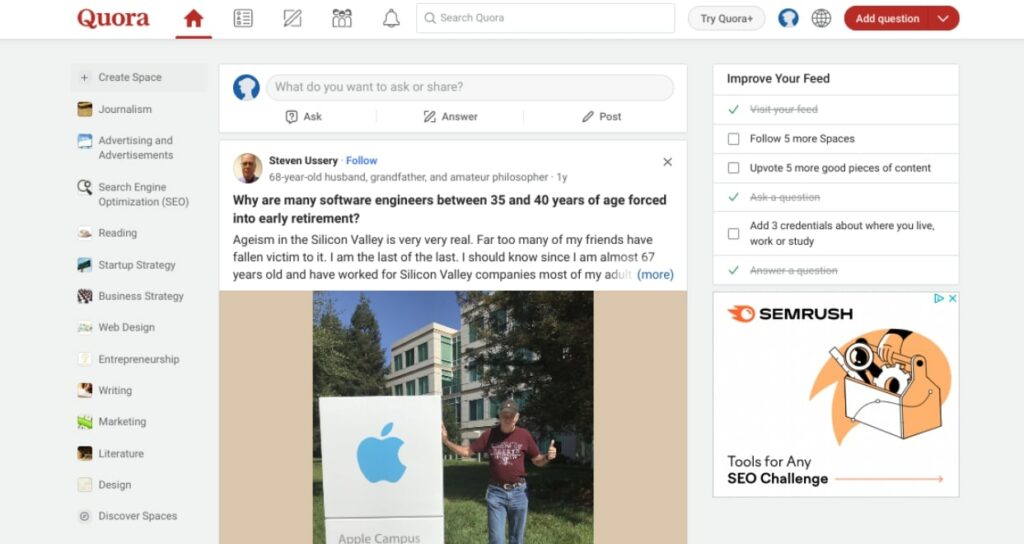
Quora is the site for answering potential customers’ questions. Its pages often rank well in Google, giving you more visibility than you might get via your own site.
As with any community, you have to make sure that the questions you answer and the advice you give are impartial. Never push your products or services, or you will get flagged, and your answers (aka your hard work) may get removed.
Reddit is an internet behemoth and, according to Statista, receives around 1.7 billion visits per month. If you can find subreddits to fit your niche, Reddit can drive a lot of traffic.
A word of caution, though: steer clear of self-promotion or your posts could be removed. If you participate in discussions around your topic and provide valuable insight, you may find you can share your content further down the line and get great results when you do.
13. Be Helpful on Forums
Many marketers look down on forums as a means of increasing traffic, largely because they’ve long been used as an “easy” link-building tool. But forums aren’t all spam. They can be (and often are) used as a legitimate means of driving traffic.
Since most popular forums have a good few years under their belt, they usually have many active members. They’re not forums, really. They’re communities that come together around a passion for a particular topic.
If you can find the right forums and be genuinely helpful in your contributions, you can consistently drive traffic to your site. There are a few things to remember:
- Don’t post links to your content too often as this could be seen as spammy
- Give detailed answers to questions, which demonstrate that you’re a go-to industry expert
- Share high-quality posts regularly
How do you find these forums? The obvious place to look is Google. A quick search usually reveals some good options. There are also tools like Find A Forum that can help you narrow down forums within your niche.
You can also use a tool like SimilarWeb:
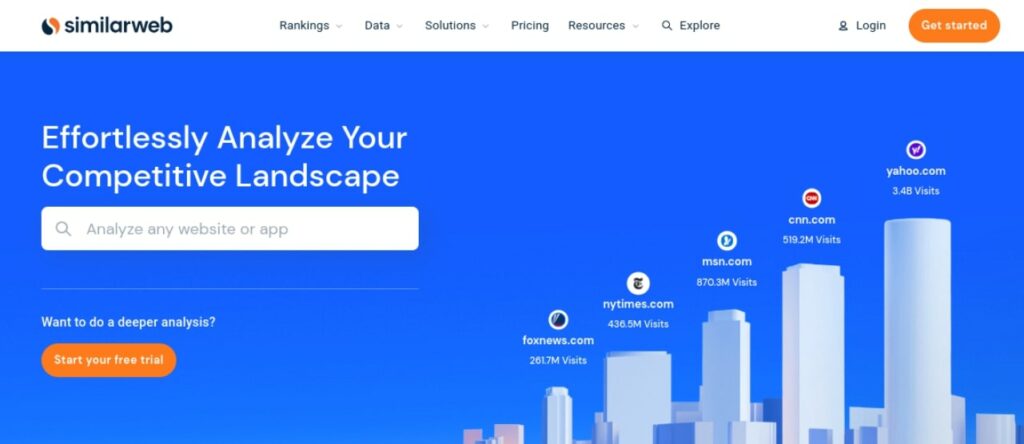
It can help you find out how much traffic each of the forums you pick attracts. This will give you an approximate idea of how many visitors they receive every month.
14. Add a Community to Your Site
If you’re in a niche that people get really passionate about, you could consider adding a community to your website. This could be a standard forum or more in the vein of a curated community like Product Hunt.
Whatever you choose, you have to make sure that it’s the right choice for your audience. As these communities grow, they attract more people, and as it’s part of your site, they will connect with your brand.
In addition, the content that your community creates can drive additional traffic by being found in the search results and via social. Passionate people can help drive traffic.
However, communities can be time-consuming to manage, and you have to make sure that content gets moderated. You might also want to consider incentivizing interaction, at least until your community gains traction. A great way to do this is to award participants points in a loyalty scheme.
15. Focus on Keywords
Keyword research is the process used to identify keywords that will help drive more traffic to a site. We typically determine a keyword’s “value” using three metrics:
- Relevancy
- Search volume
- Competition
Let’s say you’re working on a website that sells women’s shoes. Relevant keywords might include:
- Women’s sandals
- Women’s strappy sandals
- Flat women’s shoes
- Women’s shoes 3-inch heel
- Women’s ankle boots
Although these might surface when carrying out keyword research for women’s shoes, relevant keywords would definitely not include:
- Men’s shoes
- Children’s shoes
- Women’s tops
Therefore, you’d ignore these or filter them out of your research. Other things to consider when it comes to relevancy might include brand terms (you don’t want to be optimizing your site for a competitor’s name!) or terms that are too general.
Search volume is the number of people typing a particular keyword into search engines (or saying it over voice search) within a certain time frame (usually monthly). This is important because more search volume translates to greater potential to drive traffic to your site. However, search volume alone isn’t enough to determine whether a keyword is the right choice for you. You also need to consider the competition.
Also known as keyword difficulty, keyword competition is a score, typically between 0 and 100, that tells you how tough a keyword is to target. This isn’t as simple, though, as “high competition, you won’t rank” or “low competition, you will rank.” You also need to consider the strength of the site in question.
A brand new site is going to have few, if any, incoming links. This means it’ll have minimal Domain Authority (DA) and will struggle to rank for keywords with any real competition. On the other hand, a site with a DA of, say, 90+ could feasibly go after pretty much any keyword.
16. Get a Keyword Research Tool
Countless SEO tools can assist you with keyword research, and you’d be pretty hard-pressed to carry out keyword research without a tool. The trick is choosing a tool that works for you and is within your budget.
For years, the go-to keyword research tool was Google’s Keyword Planner. Unfortunately, the tool isn’t always entirely helpful unless you’re researching keywords specifically to advertise on Google — which is a shame because it’s free.
If you’re looking for the best keyword research tool, we recommend Semrush:
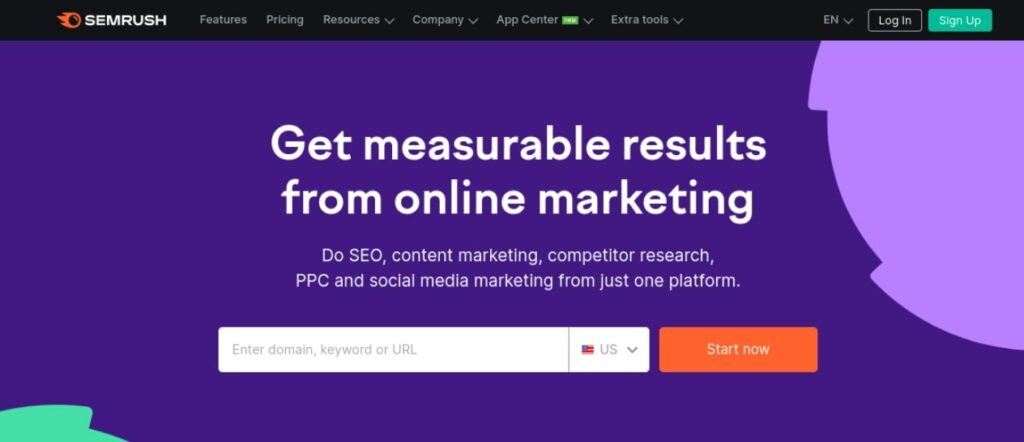
Its database includes more than 2 billion keyword opportunities. On top of that, it also provides you with information on relevant keywords, related ads, product listings, and a lot more. We’ve worked out a special 14-day trial with Semrush so you can see if this tool is a good fit for your site!
17. Optimize Your Site
After completing keyword research, it’s time to optimize the site, specifically things like title tags and <h> tags, as well as the content (the body of the page) itself.
On-page optimization is important because including the keywords you want to rank for within your <h> tags and on-page content can, well, help you rank for them. Your meta title also serves as a CTA within the Search Engine Result Pages (SERPs), enticing people to click through to your site instead of a competitor’s.
Another key component of optimization is your meta descriptions. Meta descriptions provide a short summary of a page. In many cases, they also act as sales pitches. You can use them to sum up a page’s contents and, where possible, its Unique Selling Proposition (USP).
18. Make Technical Improvements
Some of the biggest barriers to website performance in organic search and, consequently, clicks are technical. Websites with glaring technical errors will struggle to rank. In extreme cases, they might not rank at all.
Just check out Google’s Core Web Vitals project, which promises higher rankings for sites that offer a speedy User Experience (UX) to their visitors.
How do you go about identifying onsite technical issues? It generally starts with a website crawler. There are quite a few around nowadays, but when it comes to cost and usability, we have two firm favorites: Screaming Frog and Sitebulb:
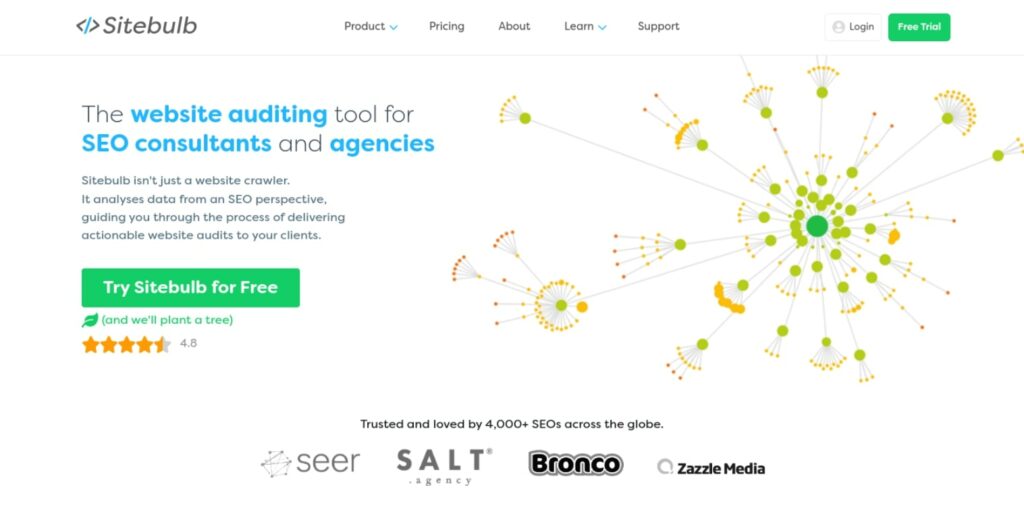
Website crawlers — or auditing tools as they’re also known — will crawl your website, following links and extracting data. They do this in much the same way as a search engine crawler.
Unlike search engine crawlers, though, auditing tools are working for you. They tell you what can be improved on your site or what’s just plain wrong with it. Whether this is duplicate content, orphaned pages, accessibility issues, structured data problems, and a whole host of other issues:
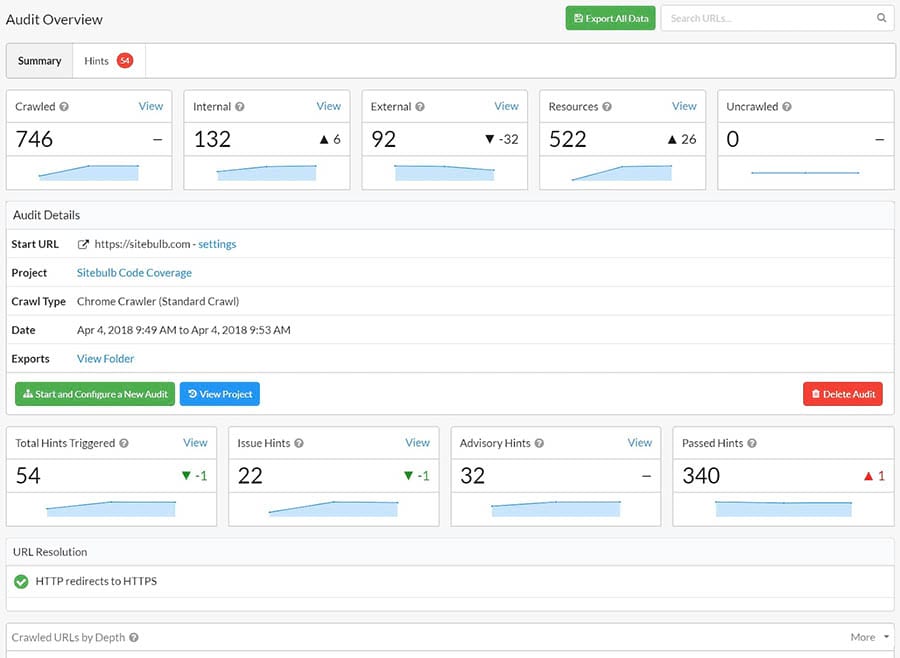
What you do with this information depends on your level of technical SEO and web development knowledge. You need the first to understand the data the auditing tools provide, and the latter to implement fixes.
Some site crawlers have come a long way. They don’t just tell you what the issue is. They explain the context and how to fix it. But they can’t hold your hand. Nor can they understand the nuances in each site’s issues. A human needs to dig through and analyze that data.
If you don’t feel confident in your own ability to understand and implement technical SEO improvements, you can start to learn with the following resources:
Alternatively, you could ask us about our SEO Marketing services. Packages start from $399 a month.
19. Start Advertising on Social
Organic social media, which is when you post to social media without paying, doesn’t always offer a high ROI for businesses. Social media platforms figured out that they make more money by reducing organic visibility to near zero and charging businesses to be seen instead.
Although organic social media might be a lame duck, paid social media costs are still — most of the time — surprisingly reasonable. According to data collated by WordStream, the average Cost Per Click (CPC) on Facebook across all industries is $1.72:
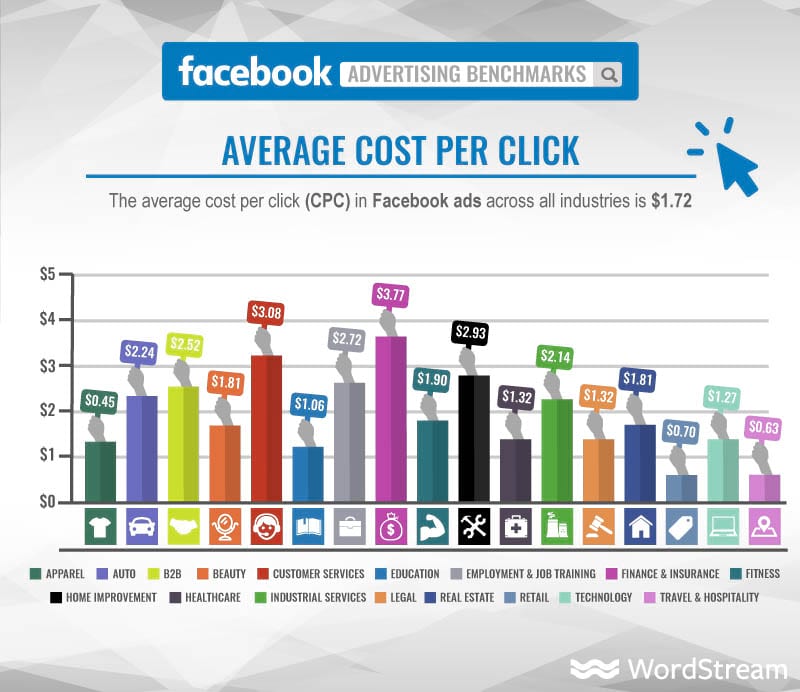
Of course, this cost varies significantly from industry to industry. Fashion and clothing brands pay the least, at approximately $0.45 a click. Finance and insurance pay the most — around $3.77. Instagram ads are generally less, between $0.70 to $1.00 per click.
There are a few reasons to drive traffic using social media over more traditional paid advertising platforms like Google AdWords. For one, it’s usually cheaper. Sometimes, significantly so.
The average CPC on Google Ads for an insurance company is an eye-watering $18.57. Fashion companies will be paying more than double what they would for a Facebook ad, around $1.19.
Social media advertising also allows you to reach potential customers where they’re relaxed and engaged. If they like your brand or product but aren’t ready to buy, they may well ‘like’ your page or profile instead. This gives you a variety of routes to market to them in the future.
20. Exchange Backlinks
Backlinks are simply links from other websites that point back to your own. They are an important part of any SEO strategy because they help search engines like Google understand which sites are popular and relevant. In turn, this can help your website rank higher in SERPs, making it more likely that people will find and visit your site.
There are a few different ways to get backlinks. One is to create high-quality content that other people will want to link to. This could be a blog post, an infographic, or even just a helpful how-to guide. You can also reach out to other website owners and ask them if they’d be interested in linking to your content.
However, it’s important to remember that not all backlinks are created equal. It’s generally considered more valuable to have a few high-quality backlinks from reputable websites than a bunch of low-quality links from less popular sites.
Again, if you’re unsure where to start, you can use a tool such as BuzzSumo. This website can help you identify popular publishers in your niche.
21. Create YouTube Video Series or Tutorials
Video marketing is becoming increasingly popular, and there are several ways that creating YouTube videos can help you drive traffic to your website. First, if you include a link to your website in the video description, viewers will be able to click on it:
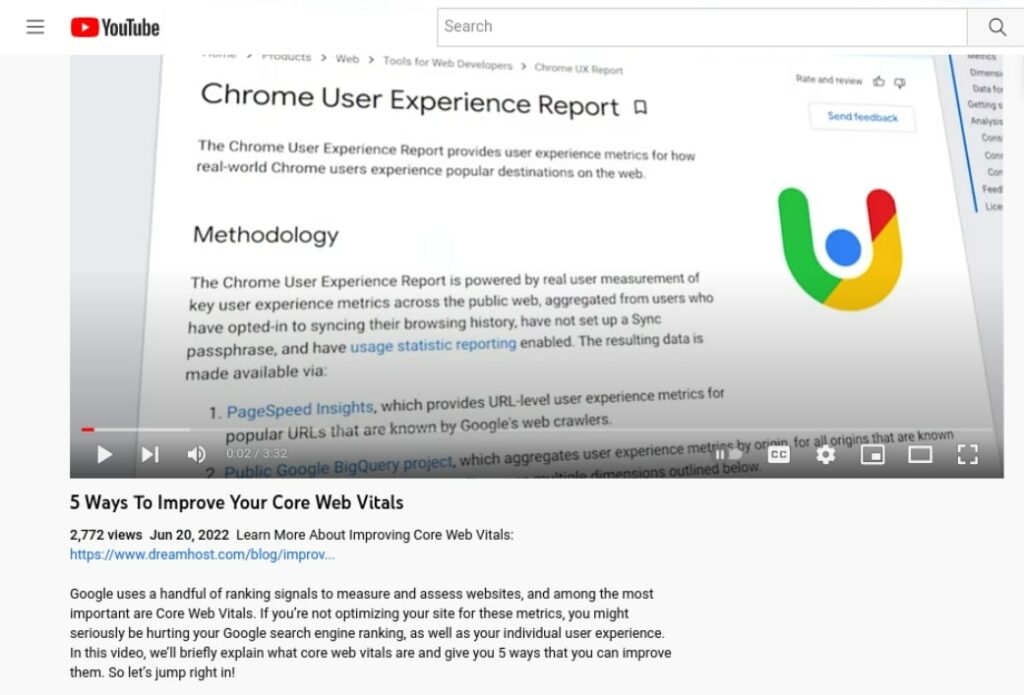
You can also promote your website in the video itself by including a CTA, such as asking viewers to subscribe to your newsletter or visit your site for more information. If you make your videos shareable and embeddable on other websites, this can also help increase traffic to your site.
22. Offer a Free Online Course
One of the best ways to drive traffic to your website is by offering a free online course. This will give potential customers an incentive to visit your site, and it can also help build brand awareness and credibility.
If you offer a high-quality course, it can also attract attention from media outlets and other websites, which can further boost traffic levels. You don’t need to have a training or education background, either.
Anyone is able to create online courses or webinars based on topic(s) they’re proficient in. Then, you can promote these courses on your website using a plugin such as LearnPress:

You can also offer it through third-party marketplaces such as Udemy. Even if it’s a free course, you can require participants to complete a registration form to enroll. This can help you build out your email list, further driving more traffic to your site.
23. Optimize the Mobile Experience of Your Website
As the number of people accessing the internet from mobile devices continues to grow, it’s more important than ever to make sure your website is optimized for mobile users. Back in 2019, Google introduced its Mobile-First Indexing, meaning that it primarily uses mobile versions of sites to index and rank in its search results.
A mobile-friendly website not only makes it easier for people to use your site on their phones, but it can also improve your search engine ranking and help you reach a wider audience.
There are a number of ways to optimize your website for mobile users, including:
- Using a responsive design
- Designing for touchscreens
- Simplifying your navigation
You can also use tools to test the current usability of your mobile site. A popular option is Google’s Mobile-Friendly Test:
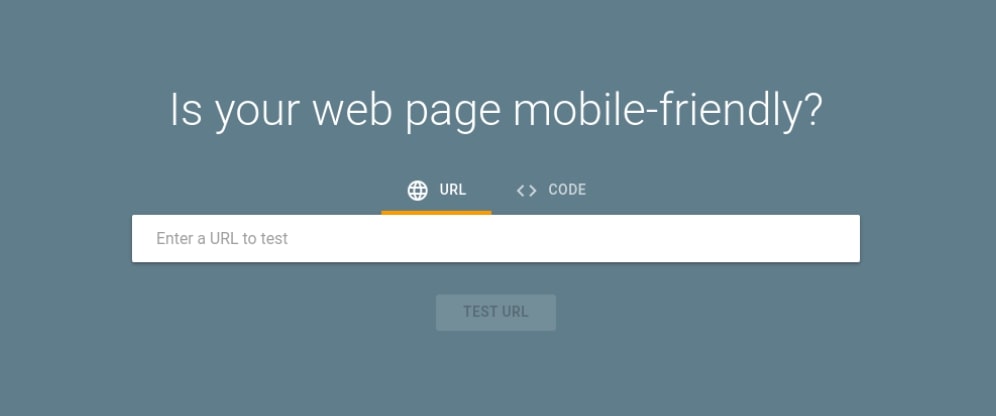
By taking the time to optimize the mobile experience of your site, you’ll ensure that more people can easily navigate and enjoy your site no matter how they access it.
24. Run Online Contests or Giveaways
There are a few key reasons why running a contest or giveaway can help drive traffic to your website. First, if you promote your contest or giveaway through social media or other online channels, you’ll likely see an uptick in traffic as people click through to enter.
Second, if you offer a prize that’s appealing and relevant to your target audience, you’ll also attract new visitors who are interested in winning. By creating lead generation or registration forms, you can collect participant details that you can later use for marketing and promotions.
Finally, contests and giveaways can create a sense of urgency and excitement around your brand, which will encourage even more people to check out your site. For more detailed advice, you can check out our guide on how to run an online giveaway.
25. Start an Affiliate Program
Affiliate marketing is a type of online advertising in which businesses or individuals promote and sell products or services on behalf of other companies. Affiliates earn a commission for each sale they generate, making it a lucrative way to drive traffic to your website:
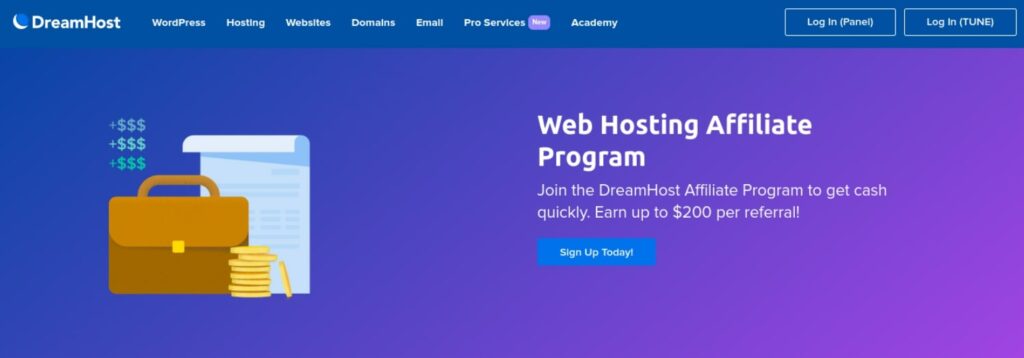
Starting an affiliate program is a great way to get more people to visit your site and learn about your products or services. By offering affiliates a commission on each sale they generate, you can encourage them to promote your business to their audiences. This can help you reach new customers and grow your business while also widening your professional network.
26. Add Social Share Buttons to Your Content
In order to drive traffic to your website, it’s important to make sure that your content is easy to share. One of the best ways to do that is by adding share triggers or social media share buttons to your posts and pages:
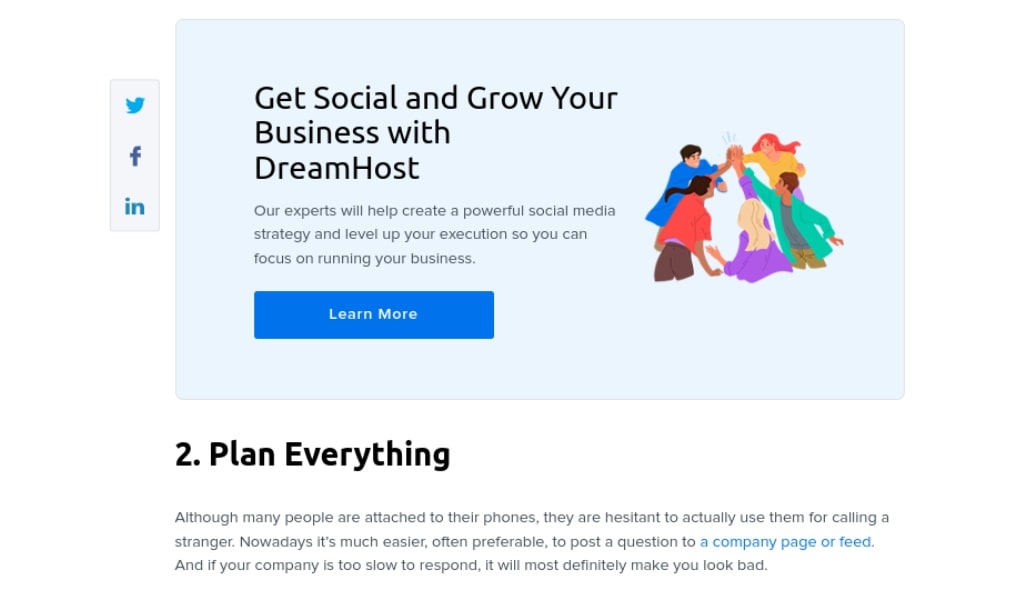
There are several reasons why you should add social share buttons to your website content. First of all, it allows your readers to easily share your content with their friends and followers, which can help boost your social media engagement.
It also helps to increase the reach of your content and get it seen by more people. Finally, it can help to build up your brand and create more awareness for your business or website.
The good news is that adding these social buttons is super simple. There are plenty of plugins, like Jetpack, for example, that can get the job done fast. To automatically add social share buttons to your content using Jetpack, you can toggle the switch under Jetpack > Settings > Sharing.
27. Create Long-Form Content
Long-form content refers to articles or pieces of writing that are longer than the average blog post or article. According to BuzzSumo and Moz research, although 85% of published content is fewer than 1,000 words, long-form content (over 1,000 words) tends to receive more shares and likes than short-form content.
These long-form pieces are usually in-depth and comprehensive, covering all aspects of a topic in detail. The format can be very helpful for SEO and website traffic because it provides searchers with the information they are looking for in a single place, instead of forcing them to click through several different websites to find what they need.
Plus, long-form content may be more likely to be shared on social media and other websites, which can help increase your website’s visibility and traffic. When you have a longer article, you have the room to dive deeper into the content and incorporate relevant keywords.
28. Optimize Your Website for Voice Search
Voice search is becoming an increasingly popular method people use to find what they’re looking for online. According to Google, nearly more than a quarter of users use voice search on their devices:

If you’re looking to optimize your website for voice search, there are a few things you can do to improve your chances of being found. First, make sure your site is mobile-friendly and responsive, as many voice searches are performed on mobile devices.
Second, use natural and concise language. This will help your site come up in more conversational searches and is ideal for voice technology assistants like Alexa. Also, when crafting your content, you should try to format it like a response, so that it could be used as the answer to someone’s question.
Finally, keep your content updated and relevant to what people are searching for. If you have a blog, make sure to post regularly and cover topics that people are eager to learn about (and search for).
29. Conduct A/B Testing
A/B testing is a method of website optimization in which two versions of a web page are shown to visitors. The version that performs better in terms of conversion rate or other metrics is used as the ‘winning’ page.
By conducting A/B tests on key pages of your website, you can improve your website’s overall traffic and conversion rates. There are a handful of tools you can choose from to conduct A/B tests. A popular option is Crazy Egg:
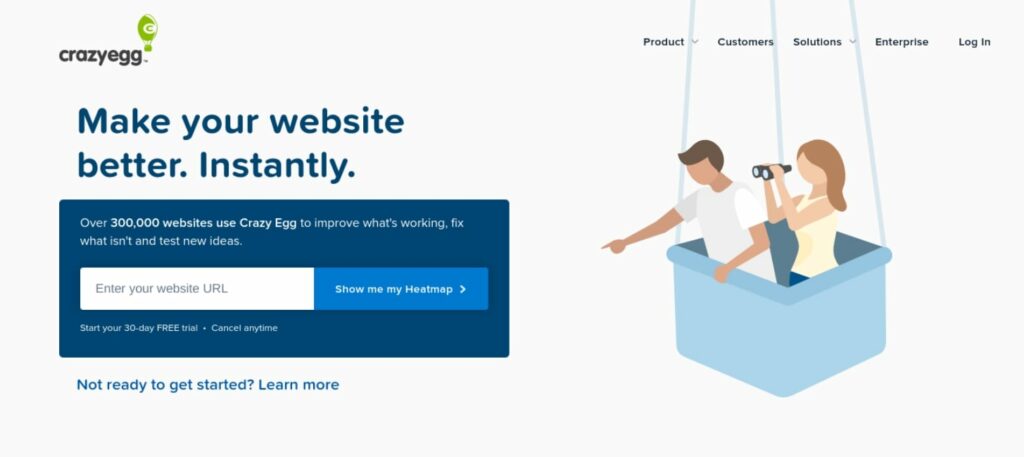
This website offers multiple tools that can help you collect meaningful insight about your pages. In addition to A/B tests, this also includes heatmaps and traffic analysis.
30. Check Out What Your Competitors Are Doing
Competitor analysis is the process of identifying and evaluating your competitors in order to gain an advantage. It can help you understand what your competitors are doing and how they are doing it. You can then use this knowledge to improve your own website and marketing efforts.
There are a number of ways to perform competitor analysis, but some of the most common methods include studying their website traffic, keyword research, backlink profile, and social media activity. By understanding these aspects of their business, you can learn from their successes and avoid their mistakes.
You can choose from a variety of online tools that can help with this. One option, which we mentioned earlier, is SimilarWeb. Not only can you enter a URL and view analytics about its traffic, but you can also learn about its traffic sources.
31. Start a Podcast
Another way you can help drive traffic to your website is by leveraging podcasts. Look for opportunities to appear on the shows of podcasters in your field. Better yet, consider starting your own.
There are a few ways that starting a podcast can help drive traffic to your website. If you include links to your website in your show notes or in your episodes themselves, listeners may be prompted to visit your site.
Additionally, if you promote your podcast on social media or other online platforms, you can include links back to your website, which can also help drive traffic. It can also help you generate leads. When you encourage listeners to subscribe to your podcast or sign up for your email list (if you have one), you can add them to your list of subscribers to target with personalized ads.
If you’re not familiar with podcasting, don’t worry. You can refer to our guide on How to Start a Podcast With WordPress, as well as our list of the 6 Best WordPress Plugins for Podcasts.
Ready to Drive Traffic to Your Website?
Now that you have these tactics in your toolbox, you should be able to put together a simple strategy for getting more people to your site. Remember, though, that this isn’t a one-off exercise, nor do you have to try everything at once or use only one tactic at a time.
Try something. See if it works. If it fails, stick at it a little longer but bring something else into your roster. Most importantly, make sure the technical aspects of your site are running smoothly — if you need to upgrade your web hosting, for example, we’ve got plans to suit any budget!
Do you need help increasing website traffic? Check out our DreamHost Pro Marketing Services to see how we can help get you started!
Grow Your Website Traffic with DreamHost
We take the guesswork (and actual work) out of growing your website traffic with SEO.
